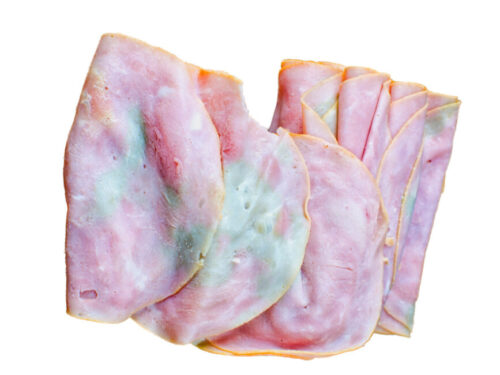We’ve all played the fridge version of “treasure hunt”, where the prize is a package of turkey or roast beef you forgot you bought. It’s a thrilling game until you’re left pondering, “Is this still good?” We’ve all been there, staring into the depths of our fridge like it’s a crystal ball that can predict food poisoning.
You gingerly pick up the package, turning it over in your hands as if it’s a delicate relic from an ancient civilization. The expiry date? Well, that’s more of a faded memory. Now comes the moment of truth. Do you take the plunge and pack it into your sandwich, or do you play it safe and toss it to avoid becoming a tragic hero in the saga of foodborne illness?
This is more than just a question of wasting food or saving a few bucks. It’s a high stakes kitchen conundrum that could either lead to a delightful lunch or a date with your least favorite bathroom fixture. So, before you start considering whether to pair that questionable cold cut with mustard or mayo, let’s put on our detective hats (and maybe some rubber gloves) and get to the bottom of this.

The Short Answer: Shelf Life of Lunch Meat
Here’s the meaty answer you’ve been waiting for. (No need to leave you hanging like a limp slice of salami.) If it’s unopened pre-packaged deli meats we’re talking about, you’re looking at a shelf life of about two weeks in the fridge, give or take a few days. But once you tear into that package of lunch meat, the countdown begins. You’ve got about 3-5 days to enjoy those slices at their best quality after the package has been opened. And remember, “best-by” dates are more like a cautious friend rather than a strict chaperone.

Unpacking the Meaty Details
- Types of Deli Meats: Fresh deli meat, straight from the deli counter, often has a shorter fridge life compared to its pre-packaged comrades. Why? It’s typically less processed, which in the world of cold meats, means a shorter stay at the “fridge hotel”.
- The Role of Preservation Methods: The longevity of luncheon meat isn’t just a twist of fate. It’s about what goes into it. Curing, smoking, and a whole host of additional ingredients work like a time machine to stretch the shelf life.
- Storage Tips: Want to keep your sandwich meat in tip-top shape? Think of your fridge as a meat spa. (Your bologna has a first name, and it’s R-E-L-A-X.) The first step to pampering your meat cuts is to store them right. Ditch the plastic bags. Airtight containers, aluminum foil, or plastic wrap are your best bets. They’re like an extra layer of protection against the harsh world (and smells) of your fridge.
- Signs of Spoilage: Trust your nose and eyes here. A sour smell, slimy texture, or any signs of mold are clear red flags. Don’t play hero with bad lunch meat. Trust me, it’s not worth the stomach cramps or possible food poisoning.

Safety First: Health Risks of Aged Lunch Meat
Let’s talk about safety, because no one wants to turn their kitchen into a danger zone. (You are not Alexander Fleming, and your fridge is not a science lab.)
When it comes to lunch meat, the stakes are higher than just a spoiled sandwich. Consuming lunch meat that’s past its prime is basically like rolling out the red carpet for some seriously unwelcome microorganisms. The most notorious of these is Listeria monocytogenes, a bacteria that doesn’t just crash your dinner party, it brings a conga line of health risks with it.
Listeria is particularly sneaky because it can thrive even in the cold environment of your fridge. That means lunch meat, especially when it’s not stored properly or kept too long, can become a playground for these bacteria. The effects can range from mild flu-like symptoms to more severe complications like meningitis, especially in vulnerable groups.
Pregnant women, listen up! Listeria is a sly villain when it comes to pregnancy. It can lead to complications such as miscarriage, premature delivery, and even life-threatening infection to your newborn. AND pregnant women are nearly 10 times MORE likely to get listeriosis than most healthy adults. In fact, it’s estimated that 1 out of 6 of all Listeria cases occur in pregnant women.That’s why health experts advise pregnant women to avoid deli meats altogether unless they’re heated to steaming hot, which is the culinary equivalent of giving Listeria its eviction notice.
But it’s not just Listeria that loves an old slice of turkey. Other pathogens, like Salmonella and E. coli, can also find a home in improperly stored or aged deli meats. These bacteria can cause food poisoning, leading to symptoms like stomach cramps, diarrhea, and vomiting.
And here’s a bit more food for thought: compromised immune systems and certain chronic diseases make people more susceptible to the effects of these bacteria. So, if your immune system isn’t exactly the Superman of bodily defenses, you might want to think twice before reaching for that questionable slice of ham.
What’s the takeaway? When in doubt, throw it out! Your gut (and possibly your bathroom) will thank you later.

The Art of Freezing and Thawing Deli Meat
When it comes to extending the life of your deli meats, your freezer is like a culinary time capsule. But it’s not just about chucking your cold cuts into the icy abyss and calling it a day. There’s an art to it, and like any good art, it involves a bit of know-how and finesse.
- Freezing Like a Pro: The goal here is to lock in freshness while banishing freezer burn to the farthest reaches of the North Pole. Heavy-duty freezer bags or wax paper are your best friends in this mission. They provide an extra layer of protection, keeping air out and freshness in. If you’re dealing with pre-packaged lunch meat, you can freeze it in its original package, but for those slices you got from the deli counter, a little extra wrapping is a good idea. I recommend laying individual slices on wax paper, and then stacking those layers within an a freezer bag. Remember to squeeze out as much air as possible to prevent freezer burn. While most deli meats freeze well, those with lower moisture content, like salami or hard salami, fare better than their juicier counterparts.
- Thawing with Thought: When it’s time to thaw, patience is a virtue. The best way to thaw deli meat is to transfer it from the freezer to the fridge and let it slowly come back to life overnight. This ensures that the meat thaws evenly and maintains its texture and flavor. In a rush? Place the meat in a resealable bag and immerse it in a bowl of cold water, and change that water frequently. This speeds up the process without sacrificing too much in terms of quality.
- Texture and Flavor: It’s important to note that freezing can cause some changes in the texture and flavor of deli meats, especially in those with a lower moisture content. They might lose a bit of their tenderness and become slightly drier. The good news is, this doesn’t hugely impact their sandwich-worthiness. Once thawed, your meat is ready to take center stage in your next culinary creation, be it a classic sandwich, a fancy charcuterie board, or a daring new recipe you’ve been itching to try.

FAQs
- How reliable is the smell test? If your lunch meat smells more like your gym socks than a fresh slice of roast beef, it’s time to say goodbye. Trust your nose; a sour smell is a clear sign of bacterial growth. HOWEVER, you should never rely on just your sense of smell to determine if your lunch meat has given up the ghost. Check for other signs like visible mold or a slimy texture. Again, when in doubt, throw it out.
- What’s the difference between the sell-by and use-by dates on lunch meat? The sell-by date is for the grocery stores. Think of it as their “sell this by” reminder. The use-by date is more for you, the consumer. It’s a general guideline for when the product will start losing quality.
- Is there a best way to store deli meat to ensure freshness? For the best quality, store deli meat in its original packaging if unopened. Once opened, transfer it to an airtight container or resealable bag. This helps maintain the right temperature and lower moisture content, keeping your cold cuts fresher for longer.
- Does the type of meat affect how long it lasts in the fridge? Indeed, it does! Different types of deli meat have varying shelf lives. Pre-packaged lunch meat generally lasts longer than freshly sliced meat from the deli counter due to added preservatives and packaging techniques.
- Can ascorbic acid in lunch meats extend their shelf life? Yes, ascorbic acid (vitamin C) is often added to lunch meats as a preservative. It helps slow down the growth of harmful bacteria, giving your sandwich meat a bit longer at the dinner table.
- Is it ever safe to eat lunch meat after the expiration date? As a general rule, it’s best to err on the side of caution. If the lunch meat is a few days past the expiration date, it’s usually okay if it’s been stored properly and shows no signs of spoilage. However, significant changes in texture or smell are HUGE red flags.
- Does cutting lunch meat into smaller portions affect its shelf life? Smaller portions can actually shorten shelf life because they increase the surface area exposed to air. It’s usually a good idea to keep lunch meat in larger slices and only cut what you need at the time.
- Can you freeze lunch meat to extend its life? Absolutely! Wrap it in heavy-duty freezer bags or wax paper for an extra layer of protection. This can be a great option for long-lasting meats like hard salami. Just remember, freezing can change the texture slightly due to ice crystals. You can freeze indefinitely, but want to enjoy within 1 to 2 months for best quality.

Conclusion
When it comes to storing your favorite deli meats, the right temperature, proper storage, and a watchful eye are key. Now, go forth and enjoy that sandwich meat without the side of worry. And hey, feel free to share your own meaty tales or tips in the comments!





0 Comments